(no subject)
Doctor Who: Hide
A Forest of Meta
spoilers through the episode
Tree / Mirror / Evangelium, Psychochronography, and Gender
Well, well, well...
The Myth of the World Tree
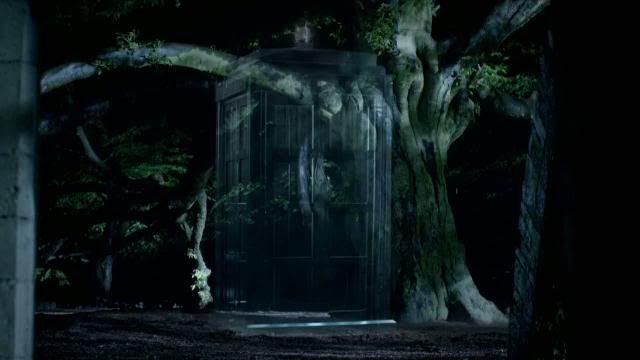
I feel like I'm on autopilot. How many more times can I write about The World Tree? I mean, I hope at this point it's obvious this is long-standing iconography here. But, just in case, here's another go. Hopefully I can still do something interesting with it!
So, in many myths around the world, there's a Tree (or a mountain) that connects Above and Below, Past and Future, Heaven and Underworld, all into the Here and Now. This axis mundi is what connects polarities, creating a union of opposites. To transcend the constructs of duality is what is often meant by "enlightenment."
DOCTOR: She's... time.
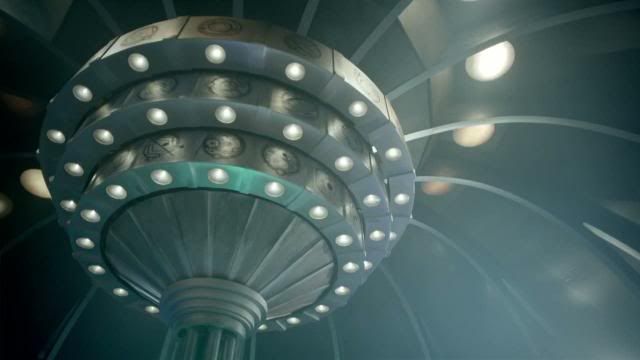

DOCTOR: Now... here she comes.
The TARDIS is herself a kind of World Tree, in that she facilitates travel between the worlds. She goes to Upperworlds (like the Rings of Akhaten) and Underworlds (like in Cold War) and every place in-between. She has her own axis mundi, the Time Rotor, which now has a lovely carousel above it, and many pretty lights and Gallifreyen hieroglyphs that evoke a "celestial" atmosphere. Like that Forest aboard the Byzantium, back in Time of Angels, where the cyborg-trees converted starlight into air.
Another similar image is The Milky Way. Seen from above, it's a spiral-shaped galaxy, but from here on earth it was once called The Cosmic Tree, for at the right inclination it emerges from the horizon like a massive ladder stretching up to the sky.
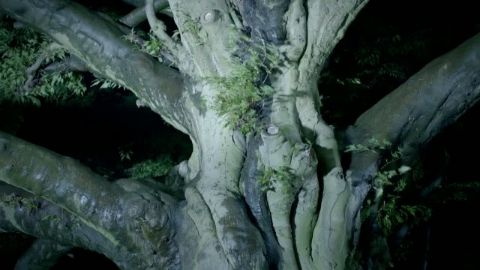
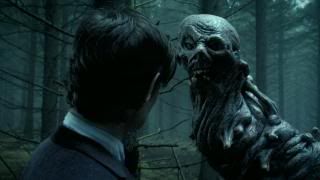
The opening image of the episode is once again tree-based, as in Rings of Akhaten. Lo and behold, the monsters are also something like knotty wood, not unlike the magnificent tree of the opening shot. And as it turns out, these monsters embody the very principle of the axis mundi -- they seek connection, the Love that binds opposites together.
And, as is the case in the previous Neil Cross story, not to mention The Wedding of River Song, the action of Love is wedded to a place of Death.
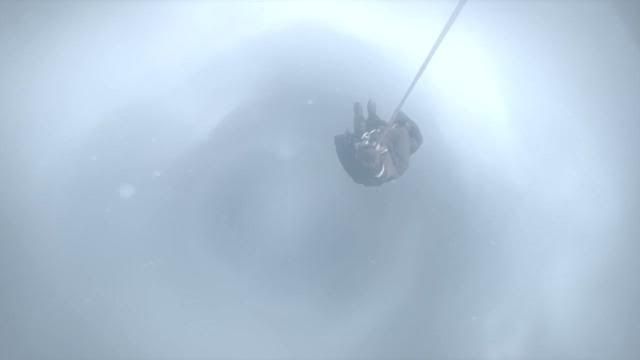
One of the things that fascinates me about Doctor Who is how it plays with metaphors for death -- or, at the very least, the near-death experience. Here we see the Doctor after he's entered the "well" and lo and behold, it's a tunnel of light. But he's not rising to the light, as is common in the NDE literature; rather, he's descending. So we get a superimposition of Heavenly visuals with an Underworld metaphor suggested by the action.
The implication is stark: the Afterlife is a manifestation of the subconscious; near-death experiences happen in the mind, not "out there." For anyone of an atheistic bent, this isn't anything new -- but that doesn't mean the near-death experience can be written off entirely, for it's still an experience, except one is beholden to the subconscious rather than any deity.
This is not unlike the Afterlife we get in the Library -- it too occurs in the mind, which is also found after a great descent. It's not "up there" but "down here."

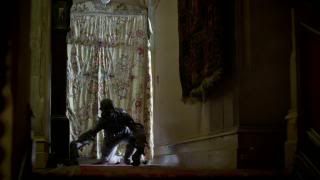
The scene in the darkroom is all Red -- this is a conversation between two men who are in Hell. Both have seen things and done things that weigh on their souls. Palmer says he's haunted by all those deaths.
Toward the end, the conversation takes a funny turn suggesting yet another near-death experience: Palmer speaks almost as if he's already died. The Doctor asks him what he'd say to the dead.
PALMER: I didn't mind dying. I mean, not for that cause. It was a very, very fine cause. Defeating the enemy.
DOCTOR: And if you could contact them, what would you say?
On the right is a picture of the Forest Monster, in front of a back-lit tapestry. The Forest Monster is at first lurking behind the Tapestry, then suddenly it's in front, as if it's slipped between the worlds. Which shouldn't surprise -- the Tapestry is a symbol for the Veil between the worlds, the curtain between what appears to be and the underlying pattern or "truth" of what it is; alternatively, the veil between Life and Death.
In ancient Greek mythology, the Sisters Fate wove a tapestry from every human life: Clotho would spin the thread, Lachesis would measure it, and Atropos would make the cut.
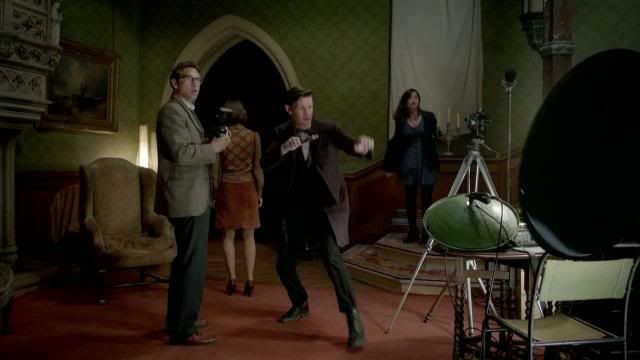
Don't pay attention to all the lovely chairs. What's striking here is that the Doctor, Clara, and Palmer are all reacting to the appearance of the Well, that Dark Mirror to the Other Side that's suddenly appeared in their living room.
But not Emma. Emma is looking through a pitch-black doorway. Emma, the psychic, looks straight into Death, and through it she gets her first glimpse of the Forest, and the ghost of her future.
The whole business with the The Well, well, I can't help but be reminded of The Ring. It's a story of an unearthly child who died in a well and who's so tortured by the experience that she's made a video that will kill you in seven days upon seeing it. She crawls out of the well and then out of the TV set to make you die of fright.
DOCTOR: What do you want? To frighten me, I suppose, eh? Because that's what you do. You hide. You're the bogeyman under the bed. Seeking whom you may devour. Ah! Ahh. You want me to be afraid? Then well done. I am the Doctor, and I am afraid!
There's been a bit of "ringing" in the season so far -- the ringing of the Bells of Saint John, the Rings of Akhaten, the ring of Clara's mother. In this story, the "ring" is an ontological time-loop. Emma and Palmer are brought together by a future that hasn't happened yet, their greatly great granddaughter, a descendent who ends up being the cause of her own birth -- because if she hadn't been born, her ancestors would never have come together at Caliburn House to investigate the ghost that brought them together in the first place.
Alternatively, Hila's been "ghosted" or put in a position where she's on the verge of death because the meeting between her greatly great grandparents is so fraught with repression that she's in danger of never having existed in the first place. In either case, though, it's Fate -- what happened, happened, and must always happen.
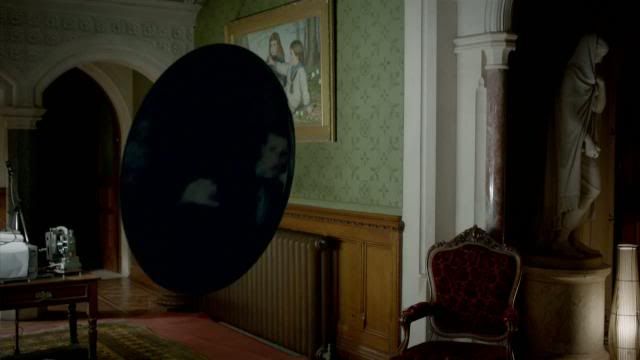
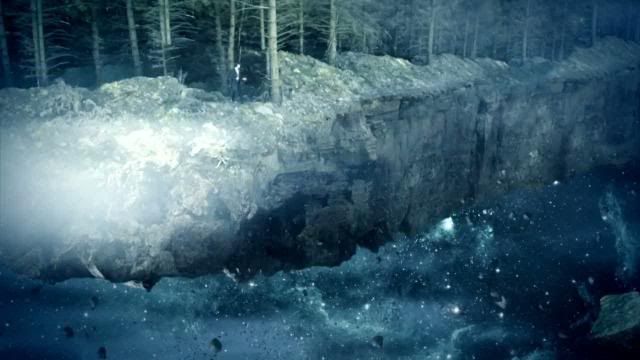
So, the Well is a Mirror to The Other Side, which is a representation of Death. This is nothing new in Doctor Who. Back in Curse of the Black Spot we had two realities conjoined through Nature's Mirror -- still water, or any reflective surface, and the Other Side was a spaceship that would take you out to the stars. In Power of Three, the Doctor asks, "Through the Looking Glass, Amelia?" before taking her to the Shakri spaceship, a place where "the dead" have been laid out and where "mythology" renders its Final Judgment.
In Hide the Mirror is a "Well" -- a place from which we draw water -- and the Other Side is a Forest, which resides on some sort of Island in the middle of the Cosmos. We've had cosmological forests before, notable in The Library and on The Byzantium.
Interestingly, the Forest, the Forest Monster, and the House are all presented through "reversed images," where the director/editor have reversed the shot in post-production. This isn't a technique that's often used in Who -- unlike, say, LOST -- but this episode is rife with Mirror Shots. Here are just a few...
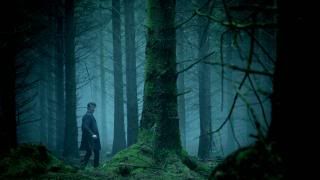
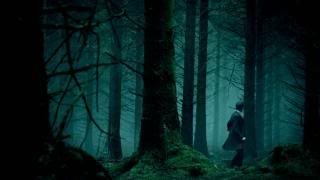
I haven't altered these shots in any way.
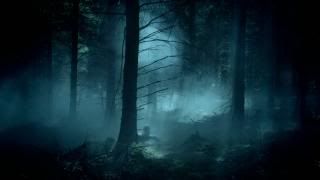
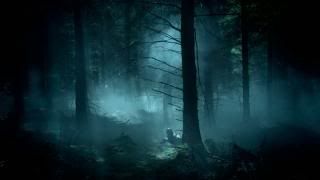
There are many more, this is just a sample.
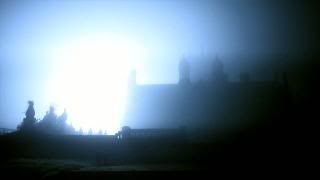
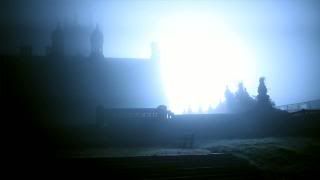
This is not to be confused with reversing the polarity. For example, the Music Room -- the Heart of Caliburn House, is presented in stark contrast, without a literal reversed image:

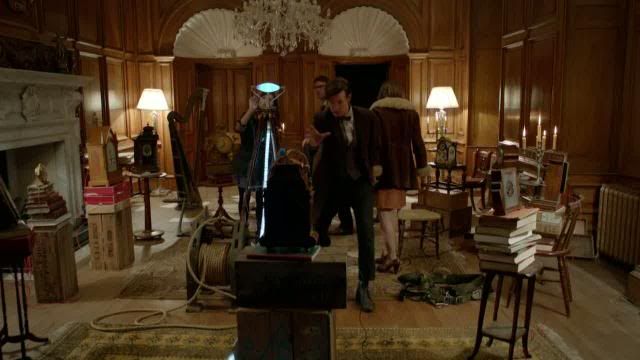
It's in the Music Room that the Doctor finds a "cold spot," and says Clara's pants are "on fire" for lying about not feeling anything in here. (A Song of Ice and Fire. Winter is Coming.)
Finally, there are lots of "lost" references again. Emma's always referring to Hila as a "lost soul," language which Palmer appropriates for self-description. He says that he was as lost as his descendant, but that being with Emma gives him a reason to be. Specifically, he says, "You brought me back from the dead." LOST, of course, was all about Death and Rebirth, and plays with the idea that if we understand that we're already dead, that this life is our afterlife, that confers a kind of freedom. No longer afraid of death, how would we conceive our lives? Our reality?
He's got an interesting name, by the way: Palmer. Sound like it would refer to "hands" -- which is another long-running motif of the show, that recurs in this episode, but "Palmer" actually means "pilgrim." See, Christian pilgrims to the Holy Land would bring back a Palm Branch with them, a reminder (and proof) of their voyage.
It all comes back to The World Tree.
Psychochronography
PALMER: What exactly is this arrangement?
DOCTOR: A psychochronograph.
PALMER: Forgive me, but isn't it all a bit, well... make-do and mend?
DOCTOR: Non-psychic technology won't work where I'm going.
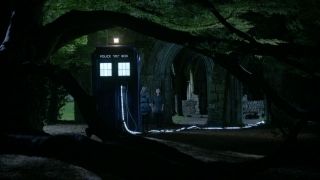
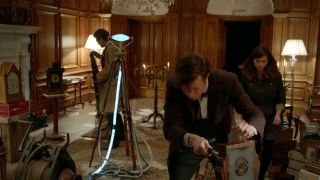
So, a bit on this mysterious word, "psychochrongraph," and the implication of psychochronography that comes with it. And along with that discussion, an digression into the ridiculous contraption that Doctor's built.
First, credit where credit is due: the word was coined by Philip Sandifer, an adaptation of the concept psychogeography as invented by Guy Debord and the Lettrist International (the forerunners of the Situationists) which is concerned with the "emotive" forces of certain parts of a city. Urban psychology, in other words. And from that core concept we got writers like Iain Sinclair and Alan Moore doing this kind of work in their fiction.
The latter's The Voice of the Fire gets into the temporal dimensions of the concept, through twelve short-stories set in the same location in varying time-periods over five-thousand years: not unlike Cross having the Doctor visit Caliburn House over the lifespan of the Earth.
Quote:
Psychochronography, a term of my own invention, attempts to move through stories and histories,
providing a "walking" tour of a time period, generally through a specific cultural object. (The Invasion)
We have always been here. Every word of this blog has taken place in this space, the mental
landscapes that comprise psychochronography. Still, incarnated here as an actual space, as
dimensions to be strolled amidst, there is something uncanny about it. No. That phrasing, that
structure, it does not apply here. There is not something uncanny about this space. (Logopolis)
-- Philip Sandifer, "A Psychochronography in Blue"
Sandifer's psychochronography is a look at psychology of Britain through the chronograph of Doctor Who; alternatively, it's a look at the psychology of Doctor Who through the chronography of Britain. Funny how mirrors work. It's a great perspective on Doctor Who from its inception through (eventually) the present day, and I can't recommend his work enough.
Anyways, it's more than apt that we have the Doctor and Clara waltzing through the history of this place, the tangible, material history of Caliburn. "Caliburn" is a previous name for "Excalibur," the sword of King Arthur. It has two origin stories: in one, Arthur gets it from pulling it out of a stone. In the other, he receives it from the Lady of the Lake. (The witch in the well?) The etymology of Caliburn is "hard" + "breach." A sword is hard, and it creates "gaps" in what it slices; it has the potential to breach the heart of the enemy.
Our heroes are the psychochronographers, taking pictures through time to understand what makes Caliburn tick, the state of its soul, its psyche, and from this evidence a narrative emerges, one that alters the very meaning of the story itself. We go from a Ghost Story -- which is a story of Death -- to a Love Story, which is the story of Life.
The Other Side therefore becomes superimposed with these two meanings, Love and Death, which turns out to be the story of Clara's Leaf back at those Rings -- for it represented both a Love Story between her parents, and the Death of her Mum in particular. This blending of contradictory forces, this fusion, is a process of Alchemy. Alchemy is a psychological art that breaks down the mutual exclusion of polarities, unifying opposites into Oneness, the better to advance our material social progress as well as our individual spiritual enlightenment. One of the main features of Alchemy is that it makes the Symbolic the functional equivalent of what it represents, at the very least within a narrative.
I bring that up in advance of what might be an objection to all this, namely that the scene with the Psychochronograph occurs after the Doctor's gone collecting his photographs; indeed, after he's already shown them. So what's up with the Clocks on Books arranged in a Circle? And what about that Shining Cord connecting the TARDIS to this magic ring? What about all this Blue Light coming out of people's foreheads?
Let's be clear, this is a "psychic technology." It's alchemical, symbolic. We have Clocks to symbolize and mark Time -- which is material change -- in conjunction with Books, which are stories, narratives, and as we've seen from the Library, the repository of the Spirit. The "silver cord" is the connection between the material and the transcendant.
Remember, the Library is called The Forest of the Dead, where consciousness resides. It's sometimes called "the Akashic Records," which is the Universal Record of every conscious or psychic experience ever in some esoteric or spiritual philosophies. This goes with with The Circle, a symbol of wholeness and completion -- though note it's also the symbol of Nothingness, the gap between the worlds -- as is the case with The Well, which is simply a dark mirror.
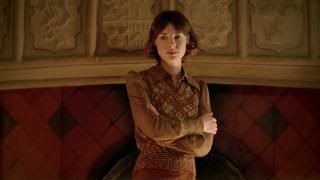

After the Doctor explains the story of psychochronographic story of Caliburn, he turns to The Girl in the Fireplace, Emma Grayling, the love-struck psychic with an open Third Eye. The blue crystal comes from Metebelis 3, a blue planet from the Classic Series. The crystals of this planet unlock the doors to the mind, and in one particular story, Planet of the Spiders, we get a blending of Western Occultism and Buddhism to usher the Doctor through his third death and rebirth. He was juxtaposed with The Great One -- the queen mother spider who would see (and control) all of Time and Space through a perfect lattice of all the planet's crystals. It literally blew her mind.
CLARA: Wake up! Wake up! Open the thing!
Anyways, I love that clock behind Emma. Looks like an Eyeball, with a blue face. It matches the crystal she's got over her Third Eye, which in conjunction with the Eye of Harmony gives her the ability to open a breach between the pocket universe and this one, right over the chalk circle the Doctor marked in this room earlier in the story. Yes, it's the same room, the Music Room, which is the heart of the house. Of course it's the Eye of Harmony (or a subset thereof) that has to be a part of this song.
So, Emma Grayling. Emma means "all containing, universal," a very interesting name for someone who's tapping into The Other Side, as represented by a Forest, the Akashic Records of Death. Her last name, Grayling, has a silvery/mercurial/mirror-like quality to it. A "grayling" is a kind of Fish. We all know how important Fish have been to the current era, from flying sharks in A Christmas Carol to mysterious goldfish in The God Complex to fish fingers and custard with Amelia Pond. (Emma is also a shortened nickname for Amelia.) In particular, the Fish -- in the form of the icthys -- is a symbol of Christian spirituality, the spirituality of self-sacrifice. Emma is willing to put her life on the line for the woman on the Other Side, and eventually the Doctor.
So, the psychochrongraph is what helps to contain and focus the psychological narrative of Caliburn House such that Emma can open a breach to the Other Side. But it's also an alchemical picture of the major psychological themes running through the current era of Who, and much else besides: the metaphorical explorations of Death, and wedding those explorations to the bliss of Love, of connection, the fusion of polarities, the union of opposites.

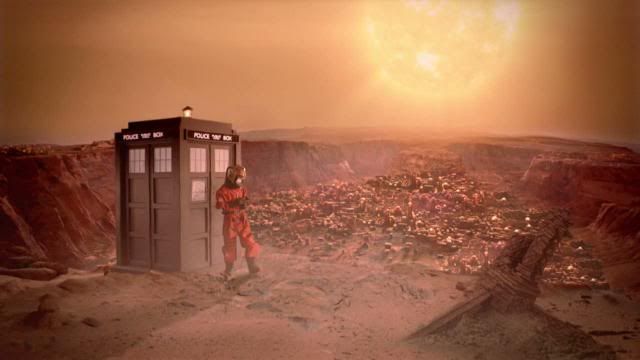
It's through the Psychochronography that Clara has her epiphany, on what it means to be dead and yet still here. The Doctor's gone to a moment of Birth, and a moment of Death -- the Beginning and the End, the Alpha and Omega -- and brought them together as One.
CLARA: I mean, one minute you're in 1974, looking for ghosts but all you have to do is
open your eyes and talk to whoever's standing there. To you, I haven't been born yet...
and to you, I've been dead 100 billion years. Is my body out there somewhere? In the ground?
DOCTOR: Yes, I suppose it is.
CLARA: But here we are, talking. So I am a ghost. To you, I'm a ghost. We're all ghosts to you.

The Doctor's taking a picture of a ghost. He's also breaking the 4th Wall. Chew on that.
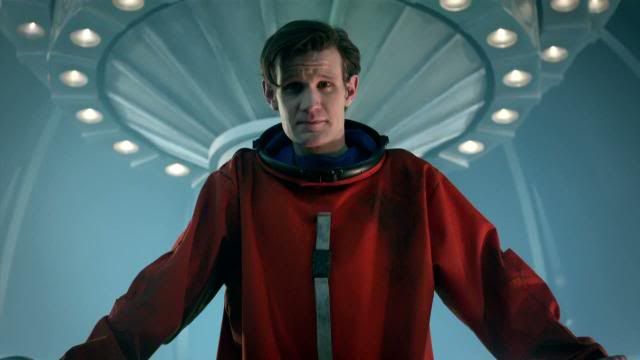
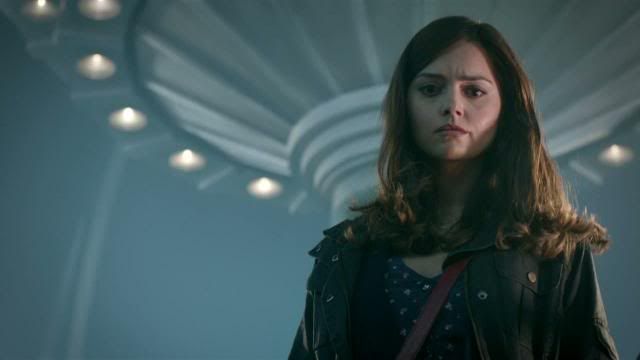
A Bechdellian Nightmare?
So, for anyone who's not familiar with Alison Bechdel and her comic strip Dykes to Watch Out For, she invented a nice little bit of feminist analysis which measures a certain kind of female centricity in a narrative. It's now called The Bechdel Test, and three simple criteria have to met to pass. The first is for the story to have more than one female character, preferably named. Second, two of these women must have a conversation. Three, at least one of their conversations must not be about men.
The converse, two men having a conversation that's not about women, well, over 90% of movies and TV episodes tend to have a conversation like that. Barely more than 50%, on the other hand, pass the Bechdel Test. So, given that this is a thing that been an issue with Who lately -- particularly with Amy in Series Seven, let's take a look at what Neil Cross is doing in Hide.
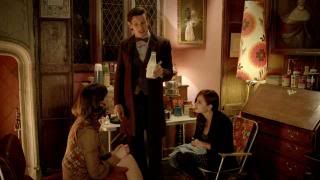
CLARA: So what's an empathic psychic?
EMMA: Sometimes I... sense feelings. The way a telepath can sense thoughts. Sometimes, though. Not always.
DOCTOR: The most compassionate people you'll ever meet, empathics. And the loneliest. I mean, exposing themselves to all those hidden feelings, all that guilt, pain and sorrow and--
Clara and Emma sit down for a chat, and lo and behold it's a conversation about Emma. Not about boys, and certainly not about the Doctor. So what does the Doctor do? He physically takes up the space between them, drinks a quart of Milk, and ends up dominating the conversation. And he's almost implicating himself -- he is the Lonely God, after all -- but at the same time demonstrating his complete lack of empathy for the intentions of these two women.
The scene is practically anti-Bechdellian, and it really ticked me off. Thank goodness Clara has the presence and verve to admonish the Doctor with a shush. But what is up with the Milk?
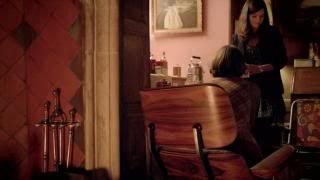
It's made even worse the next time Clara and Emma sit down to talk. As if taking their cue from the Doctor's beverage chugging, the conversation begins about the most mundane subjects, "what to drink."
EMMA: Ugh! I'd rather have a nice cup of tea.
CLARA: Me too. Whisky's the 11th most disgusting thing ever invented.
The 11th is an oblique Doctor reference. We then cut to the Darkroom, where the Doctor and Palmer have their own conversation. They talk about Palmer's previous career in the military, including an "Operation Gibbon." There isn't an operation named that as far as I could find, but interestingly there is a Doctor Gibbon who performed many operations over his lifetime. John Heysham Gibbon invented the "heart-lung machine," a device that takes over cardiopulmonary functions during open-heart surgery.
It's peculiar given that the Doctor's really interested in how this "war hero" ended up in "lonely old house" -- and we know now that he's actually smitten with Emma, but he is too repressed to say anything of the sort; this is something he has to hide. He will hide behind the guilt and pain and sorrow of all the death that comes of war.
Meanwhile, what are the women speaking of? Men. Nothing to hide here. So, another anti-Bechdellian scene, the men speak of themselves, and the women speak of the men.
CLARA: You do know how he feels about you, don't you? You of all people?
EMMA: I don't know. People like me, sometimes we get our signals mixed up. We think people are feeling the way we want them to feel. You know, when they are special to us. When, really, there's nothing there.
CLARA: Oh, this is there.
EMMA: How do you know?
CLARA: Because it's obvious. It sticks out like a big chin.
Even when talking about themselves -- Emma's blind spots, Clara's ability to read the situation -- it's couched in terms of the men in the other room. Palmer's talking about being alone and unmarried... and how he'd like to thank the enemy he defeated. But then they start talking about the woman in the photograph. Great! So how are the women doing, back by the fireplace?
Talking about the Doctor. Emma warns Clara not to trust the Doctor, he's got a sliver of ice in his heart. So, overall this conversation is one big Bechdel fail.
But what about the milk?
Milk, that's kind of significant. It was the Doctor's clue about Oswin back in the Asylum. Where did she get the milk for her soufflés? Not to mention the whole "are you real?" echoes from that episode. So, a digression.
Now, the last time we were bombarded with "milk" references was in A Good Man Goes To War, when Amy's called "Big Milk Thing" and Strax is going on about his copious lactic fluids, and Melody dissolves into a puddle of milk over her mother's breast. But Melody was brought back by a token from the World Tree, that Prayer Leaf with her name on it; as River, she is a Boon to Amy and Rory, a moment of grace to redeem that darkest hour.
10 Rejoice ye with Jerusalem, and be glad with her, all ye that love her: rejoice for joy with her, all ye that mourn for her:
11 That ye may suck, and be satisfied with the breasts of her consolations; that ye may milk out, and be delighted with the abundance of her glory.
12 For thus saith the Lord, Behold, I will extend peace to her like a river... then shall ye suck, ye shall be borne upon her sides, and be dandled upon her knees.
-- Isaiah 66
In The Hero With a Thousand Faces, Joseph Campbell describes The Ultimate Boon: the ultimate quest of the Hero, that which is sought from the Special Place to restore and heal The Ordinary World. "The supreme boon desired for the Indestructible Body is uninterrupted residence in the Paradise of the Milk that Never Fails... Soul and body food, heart's ease, is the gift of All Heal, the nipple inexhaustible. Mt Olympus rises to the heavens; gods and heroes banquet there on ambrosia..." and in Wotan's mountain hall, the thousands and thousands of heroes consume the flesh of the Cosmic Boar and wash it down with the milk of Heidrun, a she-goat who feeds on the leaves of the World Tree, Yggdrasil.
So what's the Ultimate Boon of this tale?
CLARA: Let me in, you grumpy old cow
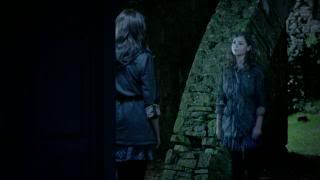
CLARA: What's this now?
TARDIS: The TARDIS Voice Visual Interface. I'm programmed to select the image of a person you esteem. Of several billion such images in my databanks, this one best meets the criterion.
CLARA: Oh, you are a cow. I knew it!
For a brief shining moment, Clara and the TARDIS have a conversation about themselves. Brief being the operative word. Clara wants to rescue the Doctor, who is in the pocket universe. Thankfully, he's only a pocket universe in this conversation.
CLARA: You can enter the pocket universe.
TARDIS: The entropy would drain the energy from my heart. In four seconds, I'd be stranded. In ten, I'd be dead.
CLARA: You're talking but all I hear is, "Meh, meh, meh." Come on, let's go!
So at least they're being heroes, going after the "damsel" in distress. Heh. Clara convinces the TARDIS to risk her life venturing off to The Other Side. The TARDIS lets Clara ride along, a bumpy disorienting ride that surely communicates how the TARDIS feels about this with more precision and feeling and, dare I say, empathy than mere words -- which, as we know, are lies, lies, lies.
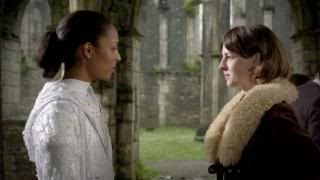
Hila and Emma do get to chat at the end. Briefly, of course. Now, this is another conversation that the Doctor interrupts. Twice. The first time, Clara pulls him back, giving them space for this:
HILA: I knew you were there... I could feel you.
EMMA: I know...
HILA: Have we...?
EMMA: We can't have. You haven't even been born yet.
Establishing that there's a relationship between these two women. Which the Doctor then interrupts to explain, spoiling them in the process. So, several short exchanges, frequently interrupted by the Doctor. The long conversations are either between the Doctor and Clara, the Doctor and Palmer, or Emma and Clara about the Doctor and Palmer.
Clara Who?
Yes, Clara gets to talk to the TARDIS. Which is something. But it's such a problematic conversation! They insult each other, cat-fighting over their man, the man with a sliver of ice in his heart. One's a cow, the other arrogantly "esteems" herself most of all (vanity, thy name is woman) and the converation ends with Clara closing off the conversation by saying, essentially, that she's not listening to the Blue Box's warnings of danger, as if the "woman" opposite her isn't even worth listening to.
But maybe I'm looking at this all wrong. What happens when it's looked at sideways, when the veil is peeled away? I can't help but think that "cow" has something do with Milk, and the very strange interruption the Doctor made between Clara and Emma earlier. Yes, Clara's insulting the TARDIS, but she's also implying that the TARDIS gives milk, which is the ambrosia of the gods, the flow of the everlasting. That the Doctor points to the TARDIS as the reason why he doesn't get upset about hanging out with all these ghosts -- why he doesn't get upset by death -- is very much in line with this symbolic reading.
And then there's the mirroring of Clara. Yes, the TARDIS says that Clara's own image was selected because it's someone Clara "esteems," but isn't this a good thing? Girls and women are often socialized to not think well of themselves, but Clara's overcome this, she is not beset with self-hatred or lack of self-esteem. True, Clara thinks the TARDIS is making a jab at her, and she may very well be given Clara's own enmity, but as far as jabs go it's an ambiguous one. Clara's not taking it as being labeled pushy or aggressive, but arrogant and egotistical, but that's Clara's projection... and it's also the problem that so many religions try to get at, the dissolution of Ego through "self-sacrifice" -- the risking of Self for the salvation of an Other.
Which leads right into the TARDIS's warnings of the danger that a trip to the pocket universe entails. As we find out from Emma in the denouement, Clara puts on a brave face, but she really is often scared. This is the fear of Ego. So the fact that the TARDIS uses Clara's image to convey the dangers they'll be facing but in a very detached if not clinical manner is a way of mirroring Clara's bravery back at her, or at the very least suggesting a strategy for dealing with that fear: detachment.
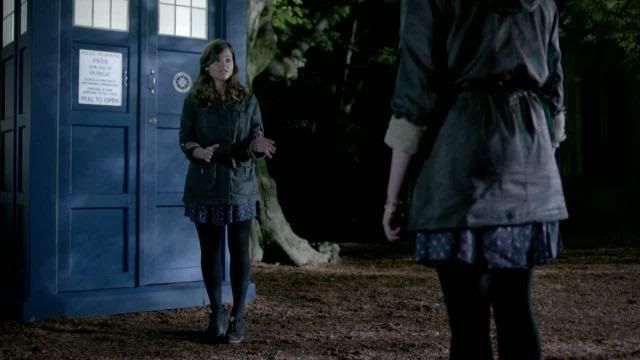
However, there are still the problematic tropes of the conversation. There are two ways to deal with problematic tropes. One is simply not to use them, providing space to foster new, healthier tropes. And frankly, I think this approach is best, because the other approach (trope subversion) is inherently problematic.
Trope subversion, as Dave Chappelle discovered, has limited effectiveness. Chappelle used all kinds of tropes to do his comedy, always with the intent of subverting them, but to his dismay he discovered that a lot of people missed the subversion completely: they weren't laughing at the inversions, but at the racist surface presentations Chappelle hoped to undermine. For some, the racist caricatures were only reinforced. On the other hand, done well, subversion can highlight and détourn a trope, undermining its effectiveness by "tagging" it such that future unironic deployments are easily noted and deflected.
I do wonder if Cross is trying to subvert tropes here. In two other conversations between women -- the first one with Emma and Clara, and the one at the end between Emma and Hila -- the Doctor intervenes, inserting himself into the dialogue uninvited. In both cases, we have Clara gently admonishing the Doctor, shushing him at first, then practically dragging him away later.
But if that's what Cross is going for, I suggest he's doing it wrong. The most problematic conversations are the ones between Clara and the TARDIS, which may well be too ambiguous and dependent on symbolism to subvert, and the second one between Emma and Clara, which is all about the men and isn't subverted at all. While the healthy trope -- women talking about anything but men -- gets interrupted by the Doctor twice. And yes he's admonished, but that pales in comparison to giving the disheartening trope a free pass.
In the end it comes across, to me at least, as a resentment towards women's conversations. At best, it's a blind spot.
Not to say that I think Neil Cross is deliberately sexist or misogynist. This is a reflection of Western culture, and I'm afraid everyone has internalized these damaging patterns. And aside from female conversations, the women depicted here are depicted quite well. Clara makes an adult of herself by saying she doesn't need to hold the Doctor's hand, even though she's scared. Emma is the one who's brave, opening up the breach to the Other Side, despite Palmer's protestations. And Hila is an early Time-Traveler who quickly adapts to her situation
So, with that out of the way, let's take one more look at Clara.
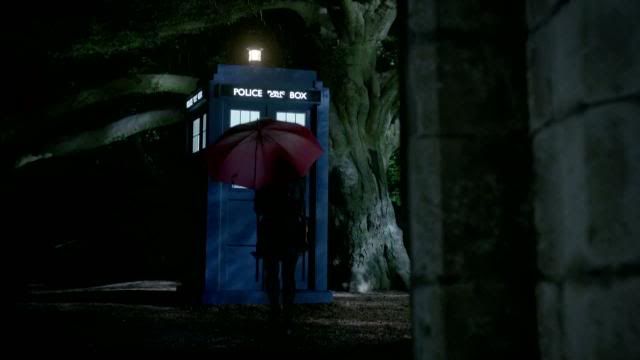
Another of the long-running motifs in Doctor Who has been the juxtaposition of the colors Red and Blue. These represent any two "polarities" bumping up against each other, but prior to integration (which yields Purple. Or White, like Amy's wedding dress. "Wedding" being an alchemical pun.)
So we get images like Melody's Red Corvette sliding up against the Blue Box, or Rory's red sports car outside the blue door to Amy's new home. Amy wearing variations of Red and Blue, and then plaid once she's integrated. Clara seems to flit back and forth between predominantly red and blue outfits -- in Snowmen, she starts in a red dress, then switches to blue. She's wearing red in Asylum and Bells, blue in Cold War and Hide.
Here she approaches the TARDIS with a Red Umbrella.
We spend an awful lot of time with the umbella.
Now, back in The Snowmen, there was all kinds of stuff going on with an umbrella, too. In that story, the Umbrella represented something like Cleverness. Both Clara and the Doctor are quite agile with that umbrella, passing it back and forth, twirling it around, what have you... Clara using it to pull down the Ladder, the Doctor using it to obliquely indicate how impressed he was with her... but when it's laid on the TARDIS console, right at that moment, the Ice Governess got her icy mitts on Clara and dragged her towards her death. In The Rings of Akhaten, it's Clara's parents who establish the intial meaning of The Leaf underneath an umbrella.
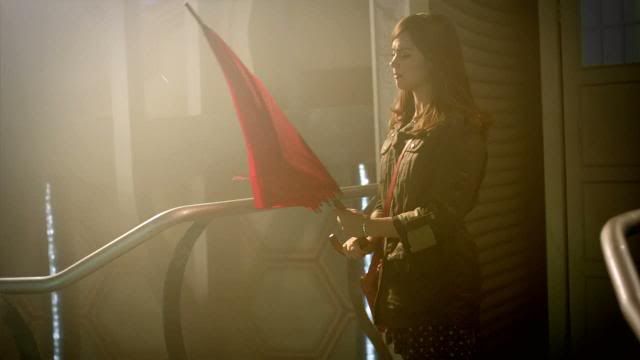
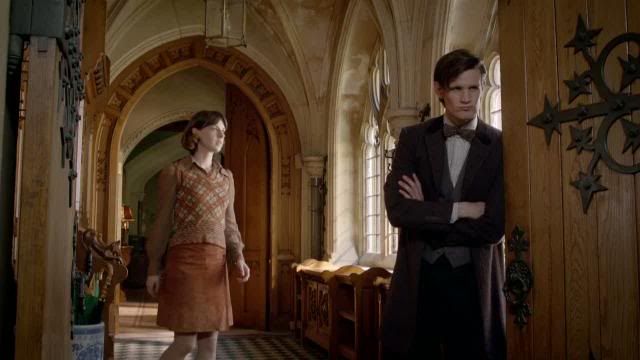
Here she's much less comfortable with the Umbrella, awkwardly trying to find a place to put it. Dripping water all over the place, for which the Doctor chides her. It's like this version of Clara isn't quite "done" yet compared to who we see in The Snowmen.
When the Doctor pulls aside Emma to talk about Clara, they are right in front of an Umbrella Stand.

But, no, Clara's not an Umbrella. No, in this episode we have her juxtaposed with the TARDIS as a literal mirror-image -- and a Ghostly one at that. But we also have her juxtaposed with a big Blue Light coming out of her forehead. Not augmented by some silly psychic crystal from Metebelis 3.
No, Clara's "third eye" is aligned with a subset of the Eye of Harmony. Part of the heart of the TARDIS.
Now, there was once a story about a TARDIS who appeared as "human." This was back in the Eighth Doctor Adventures. That TARDIS was called "Compassion." In Hide, there's careful mention to mirror the Doctor and Clara with Palmer and Emma -- the Doctor notes how Emma is the Professor's "companion." And in their conversations, there's juxtaposition between the Doctor and the Professor (who is a watercolourist, natch!) and between Clara and Emma.
Emma is empathic. The essence of compassion.

CLARA: Is she real? As in, actually real? (Hide)
OSWIN: Hello! Are you real? Are you actually, properly real? (Asylum of the Daleks)
Thanks for reading!
A Forest of Meta
spoilers through the episode
Tree / Mirror / Evangelium, Psychochronography, and Gender
Well, well, well...
The Myth of the World Tree

I feel like I'm on autopilot. How many more times can I write about The World Tree? I mean, I hope at this point it's obvious this is long-standing iconography here. But, just in case, here's another go. Hopefully I can still do something interesting with it!
So, in many myths around the world, there's a Tree (or a mountain) that connects Above and Below, Past and Future, Heaven and Underworld, all into the Here and Now. This axis mundi is what connects polarities, creating a union of opposites. To transcend the constructs of duality is what is often meant by "enlightenment."
DOCTOR: She's... time.


DOCTOR: Now... here she comes.
The TARDIS is herself a kind of World Tree, in that she facilitates travel between the worlds. She goes to Upperworlds (like the Rings of Akhaten) and Underworlds (like in Cold War) and every place in-between. She has her own axis mundi, the Time Rotor, which now has a lovely carousel above it, and many pretty lights and Gallifreyen hieroglyphs that evoke a "celestial" atmosphere. Like that Forest aboard the Byzantium, back in Time of Angels, where the cyborg-trees converted starlight into air.
Another similar image is The Milky Way. Seen from above, it's a spiral-shaped galaxy, but from here on earth it was once called The Cosmic Tree, for at the right inclination it emerges from the horizon like a massive ladder stretching up to the sky.


The opening image of the episode is once again tree-based, as in Rings of Akhaten. Lo and behold, the monsters are also something like knotty wood, not unlike the magnificent tree of the opening shot. And as it turns out, these monsters embody the very principle of the axis mundi -- they seek connection, the Love that binds opposites together.
And, as is the case in the previous Neil Cross story, not to mention The Wedding of River Song, the action of Love is wedded to a place of Death.

One of the things that fascinates me about Doctor Who is how it plays with metaphors for death -- or, at the very least, the near-death experience. Here we see the Doctor after he's entered the "well" and lo and behold, it's a tunnel of light. But he's not rising to the light, as is common in the NDE literature; rather, he's descending. So we get a superimposition of Heavenly visuals with an Underworld metaphor suggested by the action.
The implication is stark: the Afterlife is a manifestation of the subconscious; near-death experiences happen in the mind, not "out there." For anyone of an atheistic bent, this isn't anything new -- but that doesn't mean the near-death experience can be written off entirely, for it's still an experience, except one is beholden to the subconscious rather than any deity.
This is not unlike the Afterlife we get in the Library -- it too occurs in the mind, which is also found after a great descent. It's not "up there" but "down here."


The scene in the darkroom is all Red -- this is a conversation between two men who are in Hell. Both have seen things and done things that weigh on their souls. Palmer says he's haunted by all those deaths.
Toward the end, the conversation takes a funny turn suggesting yet another near-death experience: Palmer speaks almost as if he's already died. The Doctor asks him what he'd say to the dead.
PALMER: I didn't mind dying. I mean, not for that cause. It was a very, very fine cause. Defeating the enemy.
DOCTOR: And if you could contact them, what would you say?
On the right is a picture of the Forest Monster, in front of a back-lit tapestry. The Forest Monster is at first lurking behind the Tapestry, then suddenly it's in front, as if it's slipped between the worlds. Which shouldn't surprise -- the Tapestry is a symbol for the Veil between the worlds, the curtain between what appears to be and the underlying pattern or "truth" of what it is; alternatively, the veil between Life and Death.
In ancient Greek mythology, the Sisters Fate wove a tapestry from every human life: Clotho would spin the thread, Lachesis would measure it, and Atropos would make the cut.

Don't pay attention to all the lovely chairs. What's striking here is that the Doctor, Clara, and Palmer are all reacting to the appearance of the Well, that Dark Mirror to the Other Side that's suddenly appeared in their living room.
But not Emma. Emma is looking through a pitch-black doorway. Emma, the psychic, looks straight into Death, and through it she gets her first glimpse of the Forest, and the ghost of her future.
The whole business with the The Well, well, I can't help but be reminded of The Ring. It's a story of an unearthly child who died in a well and who's so tortured by the experience that she's made a video that will kill you in seven days upon seeing it. She crawls out of the well and then out of the TV set to make you die of fright.
DOCTOR: What do you want? To frighten me, I suppose, eh? Because that's what you do. You hide. You're the bogeyman under the bed. Seeking whom you may devour. Ah! Ahh. You want me to be afraid? Then well done. I am the Doctor, and I am afraid!
There's been a bit of "ringing" in the season so far -- the ringing of the Bells of Saint John, the Rings of Akhaten, the ring of Clara's mother. In this story, the "ring" is an ontological time-loop. Emma and Palmer are brought together by a future that hasn't happened yet, their greatly great granddaughter, a descendent who ends up being the cause of her own birth -- because if she hadn't been born, her ancestors would never have come together at Caliburn House to investigate the ghost that brought them together in the first place.
Alternatively, Hila's been "ghosted" or put in a position where she's on the verge of death because the meeting between her greatly great grandparents is so fraught with repression that she's in danger of never having existed in the first place. In either case, though, it's Fate -- what happened, happened, and must always happen.


So, the Well is a Mirror to The Other Side, which is a representation of Death. This is nothing new in Doctor Who. Back in Curse of the Black Spot we had two realities conjoined through Nature's Mirror -- still water, or any reflective surface, and the Other Side was a spaceship that would take you out to the stars. In Power of Three, the Doctor asks, "Through the Looking Glass, Amelia?" before taking her to the Shakri spaceship, a place where "the dead" have been laid out and where "mythology" renders its Final Judgment.
In Hide the Mirror is a "Well" -- a place from which we draw water -- and the Other Side is a Forest, which resides on some sort of Island in the middle of the Cosmos. We've had cosmological forests before, notable in The Library and on The Byzantium.
Interestingly, the Forest, the Forest Monster, and the House are all presented through "reversed images," where the director/editor have reversed the shot in post-production. This isn't a technique that's often used in Who -- unlike, say, LOST -- but this episode is rife with Mirror Shots. Here are just a few...


I haven't altered these shots in any way.


There are many more, this is just a sample.


This is not to be confused with reversing the polarity. For example, the Music Room -- the Heart of Caliburn House, is presented in stark contrast, without a literal reversed image:


It's in the Music Room that the Doctor finds a "cold spot," and says Clara's pants are "on fire" for lying about not feeling anything in here. (A Song of Ice and Fire. Winter is Coming.)
Finally, there are lots of "lost" references again. Emma's always referring to Hila as a "lost soul," language which Palmer appropriates for self-description. He says that he was as lost as his descendant, but that being with Emma gives him a reason to be. Specifically, he says, "You brought me back from the dead." LOST, of course, was all about Death and Rebirth, and plays with the idea that if we understand that we're already dead, that this life is our afterlife, that confers a kind of freedom. No longer afraid of death, how would we conceive our lives? Our reality?
He's got an interesting name, by the way: Palmer. Sound like it would refer to "hands" -- which is another long-running motif of the show, that recurs in this episode, but "Palmer" actually means "pilgrim." See, Christian pilgrims to the Holy Land would bring back a Palm Branch with them, a reminder (and proof) of their voyage.
It all comes back to The World Tree.
Psychochronography
PALMER: What exactly is this arrangement?
DOCTOR: A psychochronograph.
PALMER: Forgive me, but isn't it all a bit, well... make-do and mend?
DOCTOR: Non-psychic technology won't work where I'm going.


So, a bit on this mysterious word, "psychochrongraph," and the implication of psychochronography that comes with it. And along with that discussion, an digression into the ridiculous contraption that Doctor's built.
First, credit where credit is due: the word was coined by Philip Sandifer, an adaptation of the concept psychogeography as invented by Guy Debord and the Lettrist International (the forerunners of the Situationists) which is concerned with the "emotive" forces of certain parts of a city. Urban psychology, in other words. And from that core concept we got writers like Iain Sinclair and Alan Moore doing this kind of work in their fiction.
The latter's The Voice of the Fire gets into the temporal dimensions of the concept, through twelve short-stories set in the same location in varying time-periods over five-thousand years: not unlike Cross having the Doctor visit Caliburn House over the lifespan of the Earth.
Quote:
Psychochronography, a term of my own invention, attempts to move through stories and histories,
providing a "walking" tour of a time period, generally through a specific cultural object. (The Invasion)
We have always been here. Every word of this blog has taken place in this space, the mental
landscapes that comprise psychochronography. Still, incarnated here as an actual space, as
dimensions to be strolled amidst, there is something uncanny about it. No. That phrasing, that
structure, it does not apply here. There is not something uncanny about this space. (Logopolis)
-- Philip Sandifer, "A Psychochronography in Blue"
Sandifer's psychochronography is a look at psychology of Britain through the chronograph of Doctor Who; alternatively, it's a look at the psychology of Doctor Who through the chronography of Britain. Funny how mirrors work. It's a great perspective on Doctor Who from its inception through (eventually) the present day, and I can't recommend his work enough.
Anyways, it's more than apt that we have the Doctor and Clara waltzing through the history of this place, the tangible, material history of Caliburn. "Caliburn" is a previous name for "Excalibur," the sword of King Arthur. It has two origin stories: in one, Arthur gets it from pulling it out of a stone. In the other, he receives it from the Lady of the Lake. (The witch in the well?) The etymology of Caliburn is "hard" + "breach." A sword is hard, and it creates "gaps" in what it slices; it has the potential to breach the heart of the enemy.
Our heroes are the psychochronographers, taking pictures through time to understand what makes Caliburn tick, the state of its soul, its psyche, and from this evidence a narrative emerges, one that alters the very meaning of the story itself. We go from a Ghost Story -- which is a story of Death -- to a Love Story, which is the story of Life.
The Other Side therefore becomes superimposed with these two meanings, Love and Death, which turns out to be the story of Clara's Leaf back at those Rings -- for it represented both a Love Story between her parents, and the Death of her Mum in particular. This blending of contradictory forces, this fusion, is a process of Alchemy. Alchemy is a psychological art that breaks down the mutual exclusion of polarities, unifying opposites into Oneness, the better to advance our material social progress as well as our individual spiritual enlightenment. One of the main features of Alchemy is that it makes the Symbolic the functional equivalent of what it represents, at the very least within a narrative.
I bring that up in advance of what might be an objection to all this, namely that the scene with the Psychochronograph occurs after the Doctor's gone collecting his photographs; indeed, after he's already shown them. So what's up with the Clocks on Books arranged in a Circle? And what about that Shining Cord connecting the TARDIS to this magic ring? What about all this Blue Light coming out of people's foreheads?
Let's be clear, this is a "psychic technology." It's alchemical, symbolic. We have Clocks to symbolize and mark Time -- which is material change -- in conjunction with Books, which are stories, narratives, and as we've seen from the Library, the repository of the Spirit. The "silver cord" is the connection between the material and the transcendant.
Remember, the Library is called The Forest of the Dead, where consciousness resides. It's sometimes called "the Akashic Records," which is the Universal Record of every conscious or psychic experience ever in some esoteric or spiritual philosophies. This goes with with The Circle, a symbol of wholeness and completion -- though note it's also the symbol of Nothingness, the gap between the worlds -- as is the case with The Well, which is simply a dark mirror.


After the Doctor explains the story of psychochronographic story of Caliburn, he turns to The Girl in the Fireplace, Emma Grayling, the love-struck psychic with an open Third Eye. The blue crystal comes from Metebelis 3, a blue planet from the Classic Series. The crystals of this planet unlock the doors to the mind, and in one particular story, Planet of the Spiders, we get a blending of Western Occultism and Buddhism to usher the Doctor through his third death and rebirth. He was juxtaposed with The Great One -- the queen mother spider who would see (and control) all of Time and Space through a perfect lattice of all the planet's crystals. It literally blew her mind.
CLARA: Wake up! Wake up! Open the thing!
Anyways, I love that clock behind Emma. Looks like an Eyeball, with a blue face. It matches the crystal she's got over her Third Eye, which in conjunction with the Eye of Harmony gives her the ability to open a breach between the pocket universe and this one, right over the chalk circle the Doctor marked in this room earlier in the story. Yes, it's the same room, the Music Room, which is the heart of the house. Of course it's the Eye of Harmony (or a subset thereof) that has to be a part of this song.
So, Emma Grayling. Emma means "all containing, universal," a very interesting name for someone who's tapping into The Other Side, as represented by a Forest, the Akashic Records of Death. Her last name, Grayling, has a silvery/mercurial/mirror-like quality to it. A "grayling" is a kind of Fish. We all know how important Fish have been to the current era, from flying sharks in A Christmas Carol to mysterious goldfish in The God Complex to fish fingers and custard with Amelia Pond. (Emma is also a shortened nickname for Amelia.) In particular, the Fish -- in the form of the icthys -- is a symbol of Christian spirituality, the spirituality of self-sacrifice. Emma is willing to put her life on the line for the woman on the Other Side, and eventually the Doctor.
So, the psychochrongraph is what helps to contain and focus the psychological narrative of Caliburn House such that Emma can open a breach to the Other Side. But it's also an alchemical picture of the major psychological themes running through the current era of Who, and much else besides: the metaphorical explorations of Death, and wedding those explorations to the bliss of Love, of connection, the fusion of polarities, the union of opposites.


It's through the Psychochronography that Clara has her epiphany, on what it means to be dead and yet still here. The Doctor's gone to a moment of Birth, and a moment of Death -- the Beginning and the End, the Alpha and Omega -- and brought them together as One.
CLARA: I mean, one minute you're in 1974, looking for ghosts but all you have to do is
open your eyes and talk to whoever's standing there. To you, I haven't been born yet...
and to you, I've been dead 100 billion years. Is my body out there somewhere? In the ground?
DOCTOR: Yes, I suppose it is.
CLARA: But here we are, talking. So I am a ghost. To you, I'm a ghost. We're all ghosts to you.

The Doctor's taking a picture of a ghost. He's also breaking the 4th Wall. Chew on that.


A Bechdellian Nightmare?
So, for anyone who's not familiar with Alison Bechdel and her comic strip Dykes to Watch Out For, she invented a nice little bit of feminist analysis which measures a certain kind of female centricity in a narrative. It's now called The Bechdel Test, and three simple criteria have to met to pass. The first is for the story to have more than one female character, preferably named. Second, two of these women must have a conversation. Three, at least one of their conversations must not be about men.
The converse, two men having a conversation that's not about women, well, over 90% of movies and TV episodes tend to have a conversation like that. Barely more than 50%, on the other hand, pass the Bechdel Test. So, given that this is a thing that been an issue with Who lately -- particularly with Amy in Series Seven, let's take a look at what Neil Cross is doing in Hide.

CLARA: So what's an empathic psychic?
EMMA: Sometimes I... sense feelings. The way a telepath can sense thoughts. Sometimes, though. Not always.
DOCTOR: The most compassionate people you'll ever meet, empathics. And the loneliest. I mean, exposing themselves to all those hidden feelings, all that guilt, pain and sorrow and--
Clara and Emma sit down for a chat, and lo and behold it's a conversation about Emma. Not about boys, and certainly not about the Doctor. So what does the Doctor do? He physically takes up the space between them, drinks a quart of Milk, and ends up dominating the conversation. And he's almost implicating himself -- he is the Lonely God, after all -- but at the same time demonstrating his complete lack of empathy for the intentions of these two women.
The scene is practically anti-Bechdellian, and it really ticked me off. Thank goodness Clara has the presence and verve to admonish the Doctor with a shush. But what is up with the Milk?

It's made even worse the next time Clara and Emma sit down to talk. As if taking their cue from the Doctor's beverage chugging, the conversation begins about the most mundane subjects, "what to drink."
EMMA: Ugh! I'd rather have a nice cup of tea.
CLARA: Me too. Whisky's the 11th most disgusting thing ever invented.
The 11th is an oblique Doctor reference. We then cut to the Darkroom, where the Doctor and Palmer have their own conversation. They talk about Palmer's previous career in the military, including an "Operation Gibbon." There isn't an operation named that as far as I could find, but interestingly there is a Doctor Gibbon who performed many operations over his lifetime. John Heysham Gibbon invented the "heart-lung machine," a device that takes over cardiopulmonary functions during open-heart surgery.
It's peculiar given that the Doctor's really interested in how this "war hero" ended up in "lonely old house" -- and we know now that he's actually smitten with Emma, but he is too repressed to say anything of the sort; this is something he has to hide. He will hide behind the guilt and pain and sorrow of all the death that comes of war.
Meanwhile, what are the women speaking of? Men. Nothing to hide here. So, another anti-Bechdellian scene, the men speak of themselves, and the women speak of the men.
CLARA: You do know how he feels about you, don't you? You of all people?
EMMA: I don't know. People like me, sometimes we get our signals mixed up. We think people are feeling the way we want them to feel. You know, when they are special to us. When, really, there's nothing there.
CLARA: Oh, this is there.
EMMA: How do you know?
CLARA: Because it's obvious. It sticks out like a big chin.
Even when talking about themselves -- Emma's blind spots, Clara's ability to read the situation -- it's couched in terms of the men in the other room. Palmer's talking about being alone and unmarried... and how he'd like to thank the enemy he defeated. But then they start talking about the woman in the photograph. Great! So how are the women doing, back by the fireplace?
Talking about the Doctor. Emma warns Clara not to trust the Doctor, he's got a sliver of ice in his heart. So, overall this conversation is one big Bechdel fail.
But what about the milk?
Milk, that's kind of significant. It was the Doctor's clue about Oswin back in the Asylum. Where did she get the milk for her soufflés? Not to mention the whole "are you real?" echoes from that episode. So, a digression.
Now, the last time we were bombarded with "milk" references was in A Good Man Goes To War, when Amy's called "Big Milk Thing" and Strax is going on about his copious lactic fluids, and Melody dissolves into a puddle of milk over her mother's breast. But Melody was brought back by a token from the World Tree, that Prayer Leaf with her name on it; as River, she is a Boon to Amy and Rory, a moment of grace to redeem that darkest hour.
10 Rejoice ye with Jerusalem, and be glad with her, all ye that love her: rejoice for joy with her, all ye that mourn for her:
11 That ye may suck, and be satisfied with the breasts of her consolations; that ye may milk out, and be delighted with the abundance of her glory.
12 For thus saith the Lord, Behold, I will extend peace to her like a river... then shall ye suck, ye shall be borne upon her sides, and be dandled upon her knees.
-- Isaiah 66
In The Hero With a Thousand Faces, Joseph Campbell describes The Ultimate Boon: the ultimate quest of the Hero, that which is sought from the Special Place to restore and heal The Ordinary World. "The supreme boon desired for the Indestructible Body is uninterrupted residence in the Paradise of the Milk that Never Fails... Soul and body food, heart's ease, is the gift of All Heal, the nipple inexhaustible. Mt Olympus rises to the heavens; gods and heroes banquet there on ambrosia..." and in Wotan's mountain hall, the thousands and thousands of heroes consume the flesh of the Cosmic Boar and wash it down with the milk of Heidrun, a she-goat who feeds on the leaves of the World Tree, Yggdrasil.
So what's the Ultimate Boon of this tale?
CLARA: Let me in, you grumpy old cow

CLARA: What's this now?
TARDIS: The TARDIS Voice Visual Interface. I'm programmed to select the image of a person you esteem. Of several billion such images in my databanks, this one best meets the criterion.
CLARA: Oh, you are a cow. I knew it!
For a brief shining moment, Clara and the TARDIS have a conversation about themselves. Brief being the operative word. Clara wants to rescue the Doctor, who is in the pocket universe. Thankfully, he's only a pocket universe in this conversation.
CLARA: You can enter the pocket universe.
TARDIS: The entropy would drain the energy from my heart. In four seconds, I'd be stranded. In ten, I'd be dead.
CLARA: You're talking but all I hear is, "Meh, meh, meh." Come on, let's go!
So at least they're being heroes, going after the "damsel" in distress. Heh. Clara convinces the TARDIS to risk her life venturing off to The Other Side. The TARDIS lets Clara ride along, a bumpy disorienting ride that surely communicates how the TARDIS feels about this with more precision and feeling and, dare I say, empathy than mere words -- which, as we know, are lies, lies, lies.

Hila and Emma do get to chat at the end. Briefly, of course. Now, this is another conversation that the Doctor interrupts. Twice. The first time, Clara pulls him back, giving them space for this:
HILA: I knew you were there... I could feel you.
EMMA: I know...
HILA: Have we...?
EMMA: We can't have. You haven't even been born yet.
Establishing that there's a relationship between these two women. Which the Doctor then interrupts to explain, spoiling them in the process. So, several short exchanges, frequently interrupted by the Doctor. The long conversations are either between the Doctor and Clara, the Doctor and Palmer, or Emma and Clara about the Doctor and Palmer.
Clara Who?
Yes, Clara gets to talk to the TARDIS. Which is something. But it's such a problematic conversation! They insult each other, cat-fighting over their man, the man with a sliver of ice in his heart. One's a cow, the other arrogantly "esteems" herself most of all (vanity, thy name is woman) and the converation ends with Clara closing off the conversation by saying, essentially, that she's not listening to the Blue Box's warnings of danger, as if the "woman" opposite her isn't even worth listening to.
But maybe I'm looking at this all wrong. What happens when it's looked at sideways, when the veil is peeled away? I can't help but think that "cow" has something do with Milk, and the very strange interruption the Doctor made between Clara and Emma earlier. Yes, Clara's insulting the TARDIS, but she's also implying that the TARDIS gives milk, which is the ambrosia of the gods, the flow of the everlasting. That the Doctor points to the TARDIS as the reason why he doesn't get upset about hanging out with all these ghosts -- why he doesn't get upset by death -- is very much in line with this symbolic reading.
And then there's the mirroring of Clara. Yes, the TARDIS says that Clara's own image was selected because it's someone Clara "esteems," but isn't this a good thing? Girls and women are often socialized to not think well of themselves, but Clara's overcome this, she is not beset with self-hatred or lack of self-esteem. True, Clara thinks the TARDIS is making a jab at her, and she may very well be given Clara's own enmity, but as far as jabs go it's an ambiguous one. Clara's not taking it as being labeled pushy or aggressive, but arrogant and egotistical, but that's Clara's projection... and it's also the problem that so many religions try to get at, the dissolution of Ego through "self-sacrifice" -- the risking of Self for the salvation of an Other.
Which leads right into the TARDIS's warnings of the danger that a trip to the pocket universe entails. As we find out from Emma in the denouement, Clara puts on a brave face, but she really is often scared. This is the fear of Ego. So the fact that the TARDIS uses Clara's image to convey the dangers they'll be facing but in a very detached if not clinical manner is a way of mirroring Clara's bravery back at her, or at the very least suggesting a strategy for dealing with that fear: detachment.

However, there are still the problematic tropes of the conversation. There are two ways to deal with problematic tropes. One is simply not to use them, providing space to foster new, healthier tropes. And frankly, I think this approach is best, because the other approach (trope subversion) is inherently problematic.
Trope subversion, as Dave Chappelle discovered, has limited effectiveness. Chappelle used all kinds of tropes to do his comedy, always with the intent of subverting them, but to his dismay he discovered that a lot of people missed the subversion completely: they weren't laughing at the inversions, but at the racist surface presentations Chappelle hoped to undermine. For some, the racist caricatures were only reinforced. On the other hand, done well, subversion can highlight and détourn a trope, undermining its effectiveness by "tagging" it such that future unironic deployments are easily noted and deflected.
I do wonder if Cross is trying to subvert tropes here. In two other conversations between women -- the first one with Emma and Clara, and the one at the end between Emma and Hila -- the Doctor intervenes, inserting himself into the dialogue uninvited. In both cases, we have Clara gently admonishing the Doctor, shushing him at first, then practically dragging him away later.
But if that's what Cross is going for, I suggest he's doing it wrong. The most problematic conversations are the ones between Clara and the TARDIS, which may well be too ambiguous and dependent on symbolism to subvert, and the second one between Emma and Clara, which is all about the men and isn't subverted at all. While the healthy trope -- women talking about anything but men -- gets interrupted by the Doctor twice. And yes he's admonished, but that pales in comparison to giving the disheartening trope a free pass.
In the end it comes across, to me at least, as a resentment towards women's conversations. At best, it's a blind spot.
Not to say that I think Neil Cross is deliberately sexist or misogynist. This is a reflection of Western culture, and I'm afraid everyone has internalized these damaging patterns. And aside from female conversations, the women depicted here are depicted quite well. Clara makes an adult of herself by saying she doesn't need to hold the Doctor's hand, even though she's scared. Emma is the one who's brave, opening up the breach to the Other Side, despite Palmer's protestations. And Hila is an early Time-Traveler who quickly adapts to her situation
So, with that out of the way, let's take one more look at Clara.

Another of the long-running motifs in Doctor Who has been the juxtaposition of the colors Red and Blue. These represent any two "polarities" bumping up against each other, but prior to integration (which yields Purple. Or White, like Amy's wedding dress. "Wedding" being an alchemical pun.)
So we get images like Melody's Red Corvette sliding up against the Blue Box, or Rory's red sports car outside the blue door to Amy's new home. Amy wearing variations of Red and Blue, and then plaid once she's integrated. Clara seems to flit back and forth between predominantly red and blue outfits -- in Snowmen, she starts in a red dress, then switches to blue. She's wearing red in Asylum and Bells, blue in Cold War and Hide.
Here she approaches the TARDIS with a Red Umbrella.
We spend an awful lot of time with the umbella.
Now, back in The Snowmen, there was all kinds of stuff going on with an umbrella, too. In that story, the Umbrella represented something like Cleverness. Both Clara and the Doctor are quite agile with that umbrella, passing it back and forth, twirling it around, what have you... Clara using it to pull down the Ladder, the Doctor using it to obliquely indicate how impressed he was with her... but when it's laid on the TARDIS console, right at that moment, the Ice Governess got her icy mitts on Clara and dragged her towards her death. In The Rings of Akhaten, it's Clara's parents who establish the intial meaning of The Leaf underneath an umbrella.


Here she's much less comfortable with the Umbrella, awkwardly trying to find a place to put it. Dripping water all over the place, for which the Doctor chides her. It's like this version of Clara isn't quite "done" yet compared to who we see in The Snowmen.
When the Doctor pulls aside Emma to talk about Clara, they are right in front of an Umbrella Stand.

But, no, Clara's not an Umbrella. No, in this episode we have her juxtaposed with the TARDIS as a literal mirror-image -- and a Ghostly one at that. But we also have her juxtaposed with a big Blue Light coming out of her forehead. Not augmented by some silly psychic crystal from Metebelis 3.
No, Clara's "third eye" is aligned with a subset of the Eye of Harmony. Part of the heart of the TARDIS.
Now, there was once a story about a TARDIS who appeared as "human." This was back in the Eighth Doctor Adventures. That TARDIS was called "Compassion." In Hide, there's careful mention to mirror the Doctor and Clara with Palmer and Emma -- the Doctor notes how Emma is the Professor's "companion." And in their conversations, there's juxtaposition between the Doctor and the Professor (who is a watercolourist, natch!) and between Clara and Emma.
Emma is empathic. The essence of compassion.

CLARA: Is she real? As in, actually real? (Hide)
OSWIN: Hello! Are you real? Are you actually, properly real? (Asylum of the Daleks)
Thanks for reading!